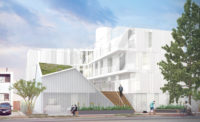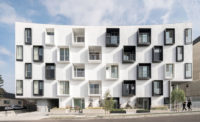When the Shulman House, high in the Hollywood Hills, was designated a Los Angeles Cultural-Historic Monument in 1987, its nomination came from none other than critic Esther McCoy, doyenne of Southern California Modernism. She cited the 1950 home as the last surviving unaltered example of Raphael Soriano's prefabricated steel-frame buildings. Originally with grounds by landscape architect Garrett Eckbo, the house was also significant for its longtime owner—legendary architectural photographer Julius Shulman— who captured the work of Richard Neutra, the Eameses, and many other talents, beginning in the midcentury period.
For Shulman's own 2,200-square-foot house and separate 1,000-square-foot studio, it's unknown exactly why he chose Soriano—a Case Study architect, though not among the most famous. Certainly the two had become colleagues early on. “And I suspect my father knew there wouldn't be the great clash of wills that he would have had with Neutra,” speculates the photographer's daughter, Judy McKee, who was 6 when she moved into the new house with her parents. Her father remained there for 59 years, until his death at age 98, in 2009, keeping the design—a cluster of glassy single-story, rectangular volumes—largely intact.
In the intervening decades, the natural backdrop also saw little change. Overlooking a land conservancy, Shulman's 0.8-acre lot retained unspoiled views of the rugged mountains, where he fondly remembered camping as a Boy Scout. But deferred maintenance took a toll, and by the time the property's new owners, a young couple, hired Los Angeles–based Lorcan O'Herlihy Architects (LOHA) in late 2010 to undertake the house's first renovation, it had frayed significantly. Its plywood interior paneling was peeling, the cork lining its entry area was brittle, the bathrooms and kitchen were tired, and the heating system flagged, raising essential questions about how to bring this Modernist work undiminished into the 21st century. “We just wanted the house to be respected,” recalls McKee. “We were very careful about whom we sold it to. There were people who wanted to turn the garage into a huge kitchen. We would have none of that.”
Given the property's cultural and historic status, the city's Office of Historic Resources (OHR) also had a say in its modification. “We needed to consider what was extant and could be preserved, and what could be restored or replaced in kind,” says Lambert Geissinger, historic-preservation architect at the OHR, which adheres to the Secretary of the Interior's Standards for Rehabilitation. “For a single-family residence that's still a home, not a house museum, we have some flexibility in balancing the preservation of historic character with accommodating upgrades, or the ways people live now.” Among the elements OHR sought to preserve were the building exterior, including its flat, uninterrupted rooflines; the original window frames; and interior cork surfaces.
O'Herlihy, who'd renovated two Neutra houses, had the advantage of having visited Shulman, then in his 90s, when he lived here. By that point, exuberantly wild grounds, dubbed “Julius's jungle” by its owner, had long since subsumed Eckbo's gardens (which McKee recalls as “beautiful, but too perfect” for her father). In tandem with O'Herlihy's renovation, landscape architect Mia Lehrer tamed the setting without reinstating the original design, for which no known documentation exists.
The indoor-outdoor lifestyle that Shulman's photos famously portrayed was essential to his own home, but he wanted transitional zones—screened-in patios—between the interior and great outdoors, with its insects, lizards, raccoons, and coyotes. Soriano, by all accounts, strongly opposed those veiled volumes, certain they would obstruct the house's crisp lines. But they were added, McKee believes shortly after the project's completion. And though “I cannot say with absolute certainty,” she continues, “I am quite sure Soriano was involved. The patios fit so perfectly and unobtrusively into the design of the house. Also, Soriano remained a good friend to us all, which wouldn't have happened had my dad gone around him.”
Without the constraints of making a house museum, O'Herlihy chose to keep the “screen boxes.” LOHA restored the exterior, including corrugated-steel siding, and meticulously refurbished the original aluminum window and sliding glass door frames. Inside, the team removed shag carpeting and resurfaced concrete floors—adding a thin, microfinished topcoat—now exposed and silky. Without changing room sizes or locations, LOHA modernized the bathrooms and the previously remodeled kitchen, replacing in kind the entry-area cork. Rather than restore Soriano's built-ins, including living room cabinets and daybeds, the architects had OHR permission to reinterpret them. Retaining original proportions and material choices, they designed streamlined fir cabinetry that subtly integrates combined heating-and-cooling units. LOHA's strategic and efficient division of the house into climate-control zones allowed for smaller mechanicals, removed from the flat roofs: a major accomplishment.
The optimistic values of Modernism championed affordable, modestly scaled, easily constructed homes, but the rising desirability of midcentury work today tends to recast it with more luxuriant qualities. Accordingly, the renovation of this house, with its sleekly elegant surfaces and iconic midcentury furnishings (more upscale than Shulman's), presents a sparer, more pared-down, and refined minimalism than the original.
Yet it's also a place where young children now frolic as McKee once did—and the spirit of Shulman lives on. Though not OHR-required, his darkroom (without equipment) remains an unrestored artifact. And a recently acquired collection of his photos animates the interior, with a one-of-a-kind relic on the coffee table: coming full circle, it's Shulman's homemade booklet documenting construction of the house.
Size: 4,000 Square feet
Project Cost: Withheld
Renovation Completion Date: November 2014
Architect:
Raphael Soriano/Lorcan O'Herlihy Architects
1537 S. La Cienega Blvd
Los Angeles, CA 90035
310.657.4363
310.657.4980
PeopleArchitect: Personnel in architect's firm who should receive special credit: Engineer(s): Consultant(s): General contractor: Photographer(s): |
ProductsExterior cladding Interior finishes Special interior finishes unique to this project: Furnishings Tables: Other furniture: Lighting Downlights: Add any additional building components or special equipment that made a significant contribution to this project: |












Post a comment to this article
Report Abusive Comment